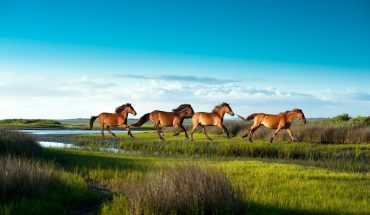The Wright Stuff
by Jesma Reynolds
photographs by Brooke Mayo
A trip to the Outer Banks via Highway 158 will take you through the hamlet of Jarvisburg, on Currituck Sound. It’s known to beach travelers who drop by the landmark gift shop The Cotton Gin – which used to be an actual cotton gin – before they continue on. Since 2008, it’s also where Sanctuary Vineyards has been growing varietals of European-style vinefera grapes and putting this coastal outpost on the map as a fine place for making award-winning fine wine.
When the words wine and North Carolina combine in a sentence, fine does not usually join them. But Sanctuary’s general manager and vineyard manager John Wright is determined to change that. He’s doing it on the seaside farm that has been in his family for seven generations, where cotton, potatoes, and soybeans have long flourished.
The UNC-Chapel Hill graduate returned home in 2001, armed with a degree in economics and a vision to preserve the rich agrarian tradition of his forefathers in an area where tourism and development were rapidly encroaching. He approached his father and uncle, joint owners of the farm, about setting aside several acres for grapes. Skeptical but agreeable, their only caveat was that he do it debt-free. As Wright says of the old-school farmers: “We don’t do loans.”
So Wright patiently explored which varietals would thrive in the farm’s harsh coastal climate. His research led him to places with similar growing conditions: Spain, southwestern France, Greece, and Croatia. Putting aside personal preferences, he found “oddball varieties” of grapes like petit manseng and Albariño that could adapt well to the loose sand and shell-deposited soil of Currituck County. One grape he knew he didn’t want to grow was the state’s native scuppernong (the official state fruit); its distinctly aromatic sweetness inspires serious oenophiles to roll their eyes.
But Wright soon realized that the grape selection process was only the beginning of a lengthy slog. Agricultural restrictions, he learned, mandate a six-year quarantine period for imported vines before they can be planted. And converting a 30,000-square-foot former mail-order building on the property into a winery without incurring any debt pulled on Wright’s resourcefulness. But persistent pluck and thriftiness paid off: He found affordable, used wine tanks from South Africa that arrived via a shipping container after several months at sea, and in 2008, he harvested his first grapes.
Three years later, Wright opened the vineyard to visitors for events, and today, the picturesque location is a popular choice for tasting room visitors, weddings, receptions, and the annual Curri-Shuck oyster festival.
The grapes
The engine that keeps this all running is the fruit, cultivated and nurtured by Wright and his winemaker Casey Matthews, who came from Raffaldini Winery in the Yadkin Valley. Their current roster of 16 varietals includes viognier, chardonnay, traminette, chardonnel, vidal blanc, cabernet sauvignon, cabernet franc, petit verdot, merlot, tempranillo, pinot noir, syrah, tannat, aglianico, petit manseng, and albariño.
A visit during growing season reveals depleted-looking grapevines, which Wright says is purposeful, forcing later ripening, and small, and intensely flavored berries. Because the soil is eroded and keeps the plants from growing large, Wright plants more of them in a row to increase their vigor. Harvesting begins in early August and runs through the end of September when the labor force swells to 15.
The hard work is paying off. Wright now has 30 acres dedicated to growing grapes, and he’s doubled production from 5,000 to 10,000 cases a year. Though the majority of sales go through the “front door” of the tasting room, Wright has recently been picked up by a distributor who is placing Sanctuary wines in restaurants and local shops across the region.
Meantime, the accolades keep piling up. Recent awards include back-to-back gold medals at the San Francisco Chronicle Wine Competition in 2015 and in 2016 for the Pearl albariño, a white wine made exclusively from estate grown albariño. The winery also received the 2015 N.C. Wine Grower of Excellence award by the North Carolina Winegrowers Association for its leadership and dedication to quality wines, something for which Wright is particularly proud.
He’s also proud of his state, convinced that North Carolina is a legitimate place for world-class viticulture. He likens his job to that of craft brewing, with its regular innovation. “I like the idea we are improving every year. Every year we’re adding something new.” And he wants the business to last, to be able one day to leave it to his now-young children. “It doesn’t feel like a job. It almost feels like reading a book. I’ve already started it. I’ve gotta keep going and find out what the ending will be.”





